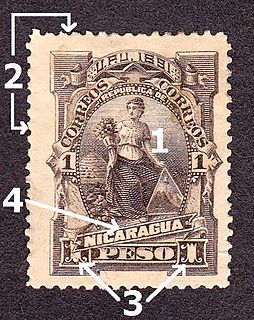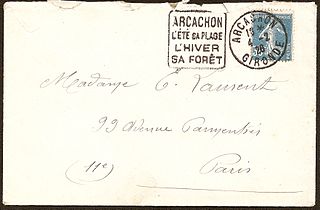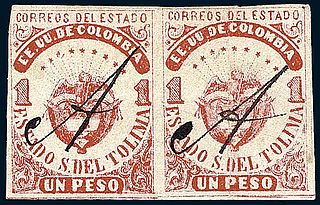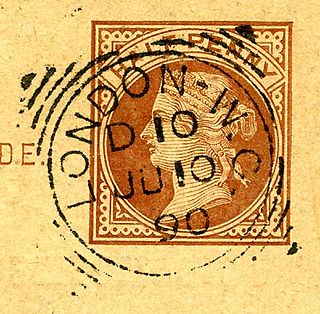
A duplex canceller was a hand stamp used to cancel postage stamps and imprint a dated postmark applied simultaneously with the one device. [1] The device had a steel die, generally circular, which printed the location of the cancel, together with the time and date of cancel. This die was held in place by a handle with an obliteration marker, often oval shaped, off to the right side that was applied over the postage stamp to prevent its reuse. [2] The ink came from an ink pad.

A cancellation is a postal marking applied on a postage stamp or postal stationery to deface the stamp and prevent its re-use. Cancellations come in a huge variety of designs, shapes, sizes and colors. Modern cancellations commonly include the date and post office location where the stamps were mailed, in addition to lines or bars designed to cover the stamp itself. The term "postal marking" sometimes is used to refer specifically to the part that contains the date and posting location, although the term often is used interchangeably with "cancellation." The portion of a cancellation that is designed to deface the stamp and does not contain writing is also called the "obliteration" or killer. Some stamps are issued pre-cancelled with a printed or stamped cancellation and do not need to have a cancellation added. Cancellations can affect the value of stamps to collectors, positively or negatively. The cancellations of some countries have been extensively studied by philatelists and many stamp collectors and postal history collectors collect cancellations in addition to the stamps themselves.

A postage stamp is a small piece of paper issued by a post office, postal administration, or other authorized vendors to customers who pay postage, who then affix the stamp to the face or address-side of any item of mail—an envelope or other postal cover —that they wish to send. The item is then processed by the postal system, where a postmark or cancellation mark—in modern usage indicating date and point of origin of mailing—is applied to the stamp and its left and right sides to prevent its reuse. The item is then delivered to its addressee.

A postmark is a postal marking made on a letter, package, postcard or the like indicating the date and time that the item was delivered into the care of the postal service. Modern postmarks are often applied simultaneously with the cancellation or killer that marks the postage stamp(s) as having been used, and the two terms are often used interchangeably, if incorrectly. Postmarks may be applied by hand or by machines, using methods such as rollers or inkjets, while digital postmarks are a recent innovation. The local post Hawai'i Post had a rubber-stamp postmark, parts of which were hand-painted. At Hideaway Island, Vanuatu, the Underwater Post Office has an embossed postmark.
In many countries the obliterator part of the canceller was coded, in various ways, to identify the post office.

Coded postal obliterators are a type of postmarks that had an obliterator encoded with a number, letter or letters, or a combination of these, to identify the post office of origin. They were introduced in the United Kingdom of Great Britain and Ireland in 1843, three years after the first stamp was issued. They became common throughout the nineteenth century but very few remained in use until the twentieth century.
In the United States, they were first used in the 1860s and use continued into the 1940s. [3]
Some machine cancelling devices like the French Daguin machine or the Italian Dani Machine also applied both the "killer" and the date stamp simultaneously. Especially in the Italian literature (and in German literature about Italian cancels) these cancelling devices are referred as duplex cancel.

The Daguin machine was one of the first cancelling machines used by the French postal administration. It was created by Eugène Daguin (1849-1888). Its first official use took place in June 1884 in Paris. It could cancel three thousand covers per hour.









